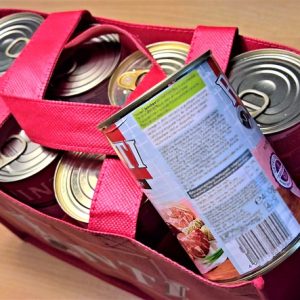No one likes discussing weight topics. It doesn’t matter whether it’s their weight or their dog’s weight. And, true, most of those veterinary visit conversations center around pups that have some extra pounds around their tummies. But that isn’t always the case. Now and then, you’ll come across a vet concerned about a drop on the scale. A dog losing weight is just as concerning as one putting it on. But as you see your canine companion every day, you might not notice unless the change is dramatic. So when does a dog losing weight become severe? And what does it mean? Is it always a sign of a disease? Not to worry – we’re going to tackle the “weighty” questions you didn’t want to ask.
A Question of Weight
Weight’s tricky. You’ll see fluctuations due to activity, hydration, and stress. And that applies whether you’re a human or a canine. This is why health professionals and trainers advise against stepping on the scale daily. There’s too much variability in what you eat and do each day. While your dog’s eating habits are probably more consistent than yours, you don’t give them the same treats. And do you walk them the same number of steps each day? Of course not. So they’ll see the same changes you might.
The problem of a dog losing weight comes in when your dog stops taking in enough calories to meet their body’s needs. And it reaches significance when they drop 10% of their normal body weight. That means for our Greyhound (who weighs 70 pounds), 7 pounds is too much. (Or, to put in perspective, she needed to GAIN 10 pounds when we adopted her, as she was coming off the racetrack and was MUCH too skinny)
A Dog Losing Weight
Unfortunately, weight loss isn’t an easy thing to pin down. You can see your dog lose weight due to changes in the environment around the house (for instance, a new pet, moving to a new house, or even new people coming in). Or if something changes with their food, they may not eat the way they have in the past. Sometimes formulas go through a change. And while YOU can’t tell the difference, your dog CAN. Suddenly, they don’t want to eat, and the pounds start dropping away.
But these examples aren’t permanent. They’re related to stress. You can reverse your dog losing weight by addressing the changes. And when you fix the problem, you’ll see the pounds go back on. Sometimes you can even get away with offering a few extra feedings to do the trick.
Where vets start to worry is when you eliminate stress from the equation. Suddenly, you have a dog losing weight for an unknown reason. That’s when it’s time to start probing deeper.
“They’re not taking in enough calories to support themselves. Either they’re a healthy dog being underfed, or they’re unwell and taking in less than they need, or they’re unwell and needing more food than usual because of an issue with absorption or digestion.”
~Shawn Finch, DVM
Recognizing Weight Loss
Unless someone’s commented on your dog losing weight, you may not always notice. This goes double for pups with thick hair coats, which often disguise the dropping weight. Instead, you may notice other signs FIRST. And it’s important to keep a record of them to help your vet down the road with puzzling out the cause of the weight loss:
- Changes in appetite (down OR up)
- Vomiting or diarrhea
- Changes in stool appearance or consistency
- Increases in thirst
- New medications (or adjustments in dosing)

Reasons For a Dog Losing Weight
Weight loss doesn’t happen overnight. It’s a gradual process as the body doesn’t receive the calories it needs to carry out life each day. But the reasons for that lack? They’re varied. They can range from tip to tail, and it’s important to pay attention to what’s going on with your canine companion to figure out which category you’re dealing with:
- Anorexia (a lack of appetite)
- Malabsorptive disorders
- Maldigestion disorders
- Metabolic disorders
- Pain
You can also see a basic need for increased calories. If your dog’s playing more, participating in more activities, pregnant, or ill, the body needs more resources. And the longer they go without? The more weight they’re going to drop.
A Dog Losing Weight: Malabsorptive Disorders
Malabsorptive disorders prevent the food your dog eats from getting into their system. SOMETHING in the GI tract blocks the nutrients. They can have a normal (or excessive) appetite, but you’ll still see your dog losing weight. And it’s because those calories don’t go where they’re supposed to.
A big culprit? Intestinal parasites. These worms hang out in your dog’s intestines, stealing all of the nutrients before they get absorbed. And it’s possible for a pup to pick up a parasite egg from almost ANYWHERE. They survive in the dirt for YEARS.
You’ll need your vet to perform a fecal test to determine which pest is causing the weight loss. Then they can prescribe a dewormer. And then, you can talk to them about routine preventatives to keep the parasites from gaining a foothold in the first place. Unfortunately, nothing’s 100% effective. This is why it’s important to get your dog in for those routine visits.
A Dog Losing Weight: Metabolic Disorders
Certain metabolic diseases can lead to weight loss. As they interfere with the way your dog’s body processes food, you’ll start to see pounds dropping away. But, again, you’ll often see an increase in your dog’s appetite. It’s that confusion of a “starving” dog that’s also losing weight that sends owners to the vet.
Diabetes
Diabetes LOVES to confuse dog owners. And the problem centers around the pancreas. As dogs age, the pancreas stops producing normal levels of insulin. Insulin’s needed to break down glucose (sugar), though. Without insulin, the body can’t process glucose for energy. So the glucose ends up passing into your dog’s urine. But the body still needs an energy source.
What’s it going to use? Fat stores. Now, before you decide that sounds awesome, there’s a catch. Fat ISN’T an effective source of energy. It’s why you see your dog losing weight. And it’s dangerous.
Diabetic dogs also start drinking and urinating a ton. Those three signs together? They’re usually a big red flag. With some quick lab work, your vet can figure out the problem. They’ll start your poor pup on insulin injections (to substitute for the lack in their body). And in no time, you’ll see them put weight back on.
Cancer
Unfortunately, cancers make dramatic changes to the body. And tumors monopolize nutrients. So when you see your dog losing weight dramatically AND losing interest in their food bowl, you need to start worrying. Weight loss is one of the biggest symptoms of most cancers – whether they’re found in the GI tract or not. You should also look for any of the following:
- Bad breath
- Excessive drool
- Trouble eating
- Coughing
- Shortness of breath
- Swollen spots
- Limping
- Changes to their urinary or defecation habits
- Lethargy
- Changes in personality
A Dog Losing Weight: Pain
Sometimes, the reason you see your dog losing weight is subtle. They’re uncomfortable. And the most common spot? Their mouth. If anything’s wrong with their teeth, they won’t eat – especially if they have dry kibble. The chewing causes so much pain, they avoid it – whether they’re hungry or not. This is why it’s so important to keep up with a regular dental cleaning routine.
You also want to stay on top of the diet choice you make. Bloating and gas? They’re painful. If your dog feels abdominal pain after every meal, they’ll make the association. Suddenly, they don’t want to eat anymore. It’s important to choose high-quality brands. If you suspect a food sensitivity, discuss making a change with your vet.
Finally, if your dog recently got into the trash or destroyed a toy? You need to get to the vet ASAP. They may have an intestinal obstruction. They’ll be in pain. They may still demonstrate an appetite, but you may see vomiting afterward. Or they could have little to no stool production (or diarrhea). The longer the blockage remains, the more your dog’s going to lose weight.
Assessing Body Condition
Weight loss doesn’t happen overnight. And you can miss the gradual change of your dog losing weight. You’ll pick up on other symptoms, but what if you want to make sure your dog’s staying at a healthy body condition? Is there a way to keep on top of that?
There is, actually. And you won’t even need to haul your dog onto the scale every day (a tricky maneuver for people with giant breeds). It’s called a body condition score (BCS), and it’s the scale your vet uses each time you go in for a visit. You examine how they look and feel, focusing on their ribs and waistline:
- Ribs: Do you see ribs sticking out? Rub your fingers along them. Can you feel them? Or is there a fat layer obscuring them?
- Waist (Above): Does your dog’s waist taper in? Or is there a single “block” from ribs to hips?
- Waist (Side): Can you see the waistline now? Or is there a straight line from the chest to the back legs?
Using a body conditioning chart can help. But make sure you keep your dog’s breed in the back of your mind. Some of the hounds SHOULD have ribs showing. And be honest with yourself. Just because you have a big dog, it doesn’t mean they should resemble a mountain.
When you take your dog in for their routine visits, they’ll step on the scale. You can ALWAYS ask the staff for the weight (and BCS). Write it down to keep track and see if your dog’s losing weight or not. Then you and your vet can discuss the changes while you’re there.
Love the Scale
Most of us? We have a love-hate relationship with our bathroom scales. But when it comes to our beloved furry friends, we need to pay attention. A dog losing weight is a cause for concern. Are they eating the same as before? Less? More? Has anything changed around the house that might have caused the switch? If not, then it’s time to dig deeper and start working with your vet to find the answer.
Thin is NOT in when it comes to dogs. You want them to be healthy, but that doesn’t mean their bones sticking out. Make sure you keep an eye on your pup’s body condition score and weight. It’s the healthiest choice – for everyone.













No comment yet, add your voice below!